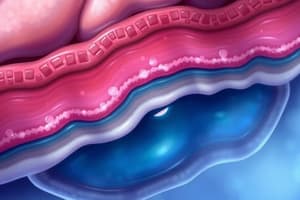Podcast
Questions and Answers
Which type of membrane is characterized by lining body structures that open to the external environment?
Which type of membrane is characterized by lining body structures that open to the external environment?
- Serous membrane
- Cutaneous membrane
- Synovial membrane
- Mucous membrane (correct)
The lamina propria is a component of which type of membrane?
The lamina propria is a component of which type of membrane?
- Cutaneous membrane
- Mucous membrane (correct)
- Synovial membrane
- Serous membrane
Which of the following membrane types does not primarily consist of an epithelial tissue layer and an underlying connective tissue layer?
Which of the following membrane types does not primarily consist of an epithelial tissue layer and an underlying connective tissue layer?
- Cutaneous membrane
- Serous membrane
- Synovial membrane (correct)
- Mucous membrane
Mesothelium is associated with which type of membrane?
Mesothelium is associated with which type of membrane?
Which fluid is produced by the membranes that line portions of the thoracic and abdominopelvic cavities?
Which fluid is produced by the membranes that line portions of the thoracic and abdominopelvic cavities?
Which of the following describes the primary function of synovial fluid?
Which of the following describes the primary function of synovial fluid?
Stratified squamous epithelium without keratin and a lamina propria are components of the mucous membrane lining which of the following?
Stratified squamous epithelium without keratin and a lamina propria are components of the mucous membrane lining which of the following?
Which type of epithelium, along with the lamina propria, comprises the lining of the urinary bladder and ureters?
Which type of epithelium, along with the lamina propria, comprises the lining of the urinary bladder and ureters?
What is the primary role of mucus produced by mucous membranes?
What is the primary role of mucus produced by mucous membranes?
The pleura, pericardium, and peritoneum are composed of what kind of membrane?
The pleura, pericardium, and peritoneum are composed of what kind of membrane?
Flashcards
Mucous Membranes
Mucous Membranes
Lines body structures that open to the external environment, such as the digestive, respiratory, reproductive, and urinary tracts.
Mucous Membrane Structure
Mucous Membrane Structure
Composed of epithelium (stratified squamous or transitional or simple columnar or PCCE) + lamina propria (areolar CT).
Serous Membranes
Serous Membranes
Line body cavities that do not open externally, such as the thoracic and abdominopelvic cavities.
Serous Membrane Structure
Serous Membrane Structure
Signup and view all the flashcards
Serous Fluid Function
Serous Fluid Function
Signup and view all the flashcards
Cutaneous Membrane
Cutaneous Membrane
Signup and view all the flashcards
Cutaneous Membrane Structure
Cutaneous Membrane Structure
Signup and view all the flashcards
Synovial Membranes
Synovial Membranes
Signup and view all the flashcards
Synovial Fluid Function
Synovial Fluid Function
Signup and view all the flashcards
Synovial Membrane Structure
Synovial Membrane Structure
Signup and view all the flashcards
Study Notes
- There are four membrane types: mucous, serous, cutaneous, and synovial.
- Membranes consist of two or more tissue types, with epithelial tissues being just one component of a more complex membrane.
- Membranes line a free surface and typically include epithelial tissue at the surface plus underlying connective tissue(s).
- Each membrane produces one or more products like mucus, serous fluid, synovial fluid, or sweat/oil.
Mucous Membranes
- Line body structures that open to the external environment, such as the digestive, respiratory, reproductive, and urinary tracts.
- Structure includes an epithelial tissue and a layer of areolar connective tissue called the lamina propria.
- Produce mucus, a slippery and viscous fluid.
- Examples:
- Lining of oral cavity, esophagus, vulva: stratified squamous epithelium (without keratin) + lamina propria of areolar CT
- Lining of urinary bladder and ureters: transitional epithelium + lamina propria
- Lining of stomach and intestines: simple columnar epithelium + lamina propria
- Lining of nasal cavity and trachea: pseudostratified ciliated columnar epithelium (PCCE) + lamina propria
- Goblet cells are unicellular exocrine glands found in the PCCE of the trachea that secrete mucus.
Serous Membranes
- Line body cavities that do not open externally, like portions of the thoracic and abdominopelvic cavities.
- Examples: pleura, pericardium, and peritoneum.
- Structure consists of a thin epithelium (simple squamous epithelial tissue called mesothelium) and areolar connective tissue.
- Produce serous fluid, a watery secretion.
Cutaneous Membrane (Skin)
- Located externally
- Structure includes the epidermis (epithelial tissue) and dermis (connective tissue).
- Functions include secretion by exocrine glands.
Synovial Membranes
- Found in freely movable joints like the knee, hip, and elbow.
- Produce synovial fluid, a viscous fluid that nourishes articular cartilage and lubricates joints.
- Synovial fluid is often compared to egg white in consistency.
- Structure is unique, lacking a true epithelial tissue and consisting of a unique connective tissue structure lining synovial joint cavities.
Studying That Suits You
Use AI to generate personalized quizzes and flashcards to suit your learning preferences.




